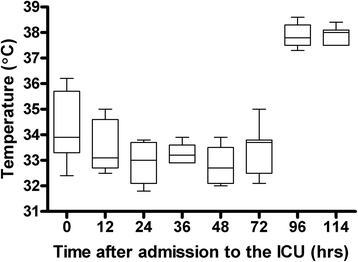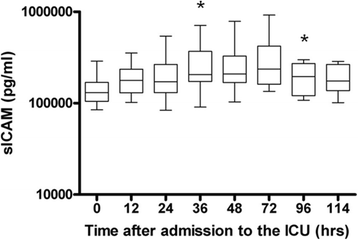Seventy-two hours of mild hypothermia after cardiac arrest is associated with a lowered inflammatory response during rewarming in a prospective observational study
- PMID: 25304549
- PMCID: PMC4209077
- DOI: 10.1186/s13054-014-0546-5
Seventy-two hours of mild hypothermia after cardiac arrest is associated with a lowered inflammatory response during rewarming in a prospective observational study
Abstract
Introduction: Whole-body ischemia and reperfusion trigger a systemic inflammatory response. In this study, we analyzed the effect of temperature on the inflammatory response in patients treated with prolonged mild hypothermia after cardiac arrest.
Methods: Ten comatose patients with return of spontaneous circulation after pulseless electrical activity/asystole or prolonged ventricular fibrillation were treated with mild therapeutic hypothermia for 72 hours after admission to a tertiary care university hospital. At admission and at 12, 24, 36, 48, 72, 96 and 114 hours, the patients' temperature was measured and blood samples were taken from the arterial catheter. Proinflammatory interleukin 6 (IL-6) and anti-inflammatory (IL-10) cytokines and chemokines (IL-8 and monocyte chemotactic protein 1), intercellular adhesion molecule 1 and complement activation products (C1r-C1s-C1inhibitor, C4bc, C3bPBb, C3bc and terminal complement complex) were measured. Changes over time were analyzed with the repeated measures test for nonparametric data. Dunn's multiple comparisons test was used for comparison of individual time points.
Results: The median temperature at the start of the study was 34.3°C (33.4°C to 35.2°C) and was maintained between 32°C and 34°C for 72 hours. All patients were passively rewarmed after 72 hours, from (median (IQR)) 33.7°C (33.1°C to 33.9°C) at 72 hours to 38.0°C (37.5°C to 38.1°C) at 114 hours (P <0.001). In general, the cytokines and chemokines remained stable during hypothermia and decreased during rewarming, whereas complement activation was suppressed during the whole hypothermia period and increased modestly during rewarming.
Conclusions: Prolonged hypothermia may blunt the inflammatory response after rewarming in patients after cardiac arrest. Complement activation was low during the whole hypothermia period, indicating that complement activation is also highly temperature-sensitive in vivo. Because inflammation is a strong mediator of secondary brain injury, a blunted proinflammatory response after rewarming may be beneficial.
Figures





References
-
- Holzer M, Bernard SA, Hachimi-Idrissi S, Roine RO, Sterz F, Müllner M, the Collaborative Group on Induced Hypothermia for Neuroprotection After Cardiac Arrest Hypothermia for neuroprotection after cardiac arrest: systematic review and individual patient data meta-analysis. Crit Care Med. 2005;33:414–418. doi: 10.1097/01.CCM.0000153410.87750.53. - DOI - PubMed
Publication types
MeSH terms
Substances
LinkOut - more resources
Full Text Sources
Other Literature Sources
Medical
Research Materials
Miscellaneous

